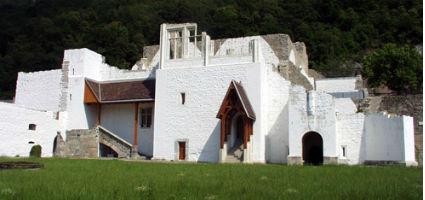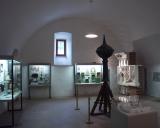2025. July 19. Saturday
Hungarian National Museum King Mathias Museum - Visegrád
 |
Address: 2025, Visegrád Fő utca 23.
Phone number: (26) 597-010
E-mail: info@visegradmuzeum.hu
Opening hours: Tue-Sun 9-17
|
The excavation works at the most well-known historic building of Visegrád began in the 1870's. The finds were moved to the National Museum. In 1927, the Castle Committee was established to save the ruins of the castle.
The first compilation was created in 1933 with the help of the committee and the management of Schulek János who inventoried the finds and placed them in the store of the Salamon Tower.
In 1935, the focus of the excavation works was placed on the Royal Palace. The new finds needed a new storage building. In 1940, the collection was moved to the Hunter Castle close to the ruins.
A stone gallery was planned among the ruins, but it was never realized due to WWII. The excavation works were also halted during the war, but continued from 1948 with the supervision of Dercsényi Dezső and Héjj Miklós. First, the compilation was moved to the National Museum but in the 1950's it took on the name Mathias Rex Museum.
New excavations began at the Roman limes and the Lord Lieutenant Center of the Árpád age. Considering its size and professionals working for the museum, it is one of the most significant in the country. The region it collects from is the Visegrád and Nagymaros region.
It also holds a local history compilation that presents the history of Visegrád populated by German settlers in the 18th century, ethnographic memories and the compositions of artists who lived or worked in town.
The most important national monuments are maintained by the town: the Royal Palace, the Lower Castle, and the ruins of the archdeacon church. The permanent exhibitions are held in the Salamon Tower and the reconstructed wards of the Royal Palace.
The museum is among the most often visited museums of the Dunakanyar. The number of visitors reached 15 000 in.
The first compilation was created in 1933 with the help of the committee and the management of Schulek János who inventoried the finds and placed them in the store of the Salamon Tower.
In 1935, the focus of the excavation works was placed on the Royal Palace. The new finds needed a new storage building. In 1940, the collection was moved to the Hunter Castle close to the ruins.
A stone gallery was planned among the ruins, but it was never realized due to WWII. The excavation works were also halted during the war, but continued from 1948 with the supervision of Dercsényi Dezső and Héjj Miklós. First, the compilation was moved to the National Museum but in the 1950's it took on the name Mathias Rex Museum.
New excavations began at the Roman limes and the Lord Lieutenant Center of the Árpád age. Considering its size and professionals working for the museum, it is one of the most significant in the country. The region it collects from is the Visegrád and Nagymaros region.
It also holds a local history compilation that presents the history of Visegrád populated by German settlers in the 18th century, ethnographic memories and the compositions of artists who lived or worked in town.
The most important national monuments are maintained by the town: the Royal Palace, the Lower Castle, and the ruins of the archdeacon church. The permanent exhibitions are held in the Salamon Tower and the reconstructed wards of the Royal Palace.
The museum is among the most often visited museums of the Dunakanyar. The number of visitors reached 15 000 in.
